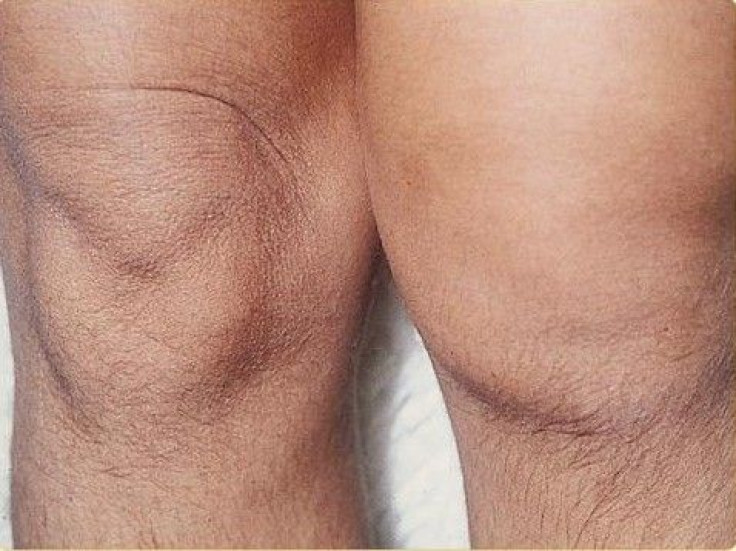Juvenile Idiopathic Arthritis Stories: Natalie Wright, 27, Must Constantly Get Joints Replaced

A simple viral infection during a five-year-old girl’s first year of school would leave her with a condition that would require new knees, hips, and a new shoulder all by the age of 27. Natalie Wright, from Ellesmere Port, Cheshire, U.K. was diagnosed with juvenile idiopathic arthritis (JIA) at the tender age of five after being sent home from school for falling ill. 24 hours later, Natalie could no longer move any part of her body, remaining bedridden for 18 months.
“It just came on completely randomly and when I tried to move, I just screamed in pain,” Natalie recalled to the Daily Mail.
During Natalie’s childhood, she was confined to a wheelchair because of the severity of pain brought on by her condition. In order to control her mobility and pain, she received the dosage of UV steroids and immunoglobins.
“I spent most of my childhood years trying to get on track and lead a semi-normal life. There have been times when I have been able to walk unaided or on crutches but other times I was bedridden,” Natalie said to the Daily Mail.
Early indicators of the chronic condition in children include pain, swelling, stiffness, and a loss of motion in the joints such as muscles, tendons, ligaments, and bones. Typically, if the symptoms remain consistent for more than six weeks, it is likely that the child will be diagnosed with JIA. These symptoms can have a profound impact on a child’s ability to perform everyday activities because of the physical limitations they cause, says the Childrens Chronic Arthritis Association UK.
Although Natalie could not be very active, she still led a normal school life and just missed physical education classes because of her physical limitations.
While the young woman’s condition deteriorated well into her adulthood, she still went to university and landed a dream job as an occupational therapist in Runcorn three years later despite the many hardships she faced.
"I missed so many days of university because I could not physically get up," Natalie told the BBC in an interview five years ago. "Quite often I would go in to university and then have to go home to take painkillers and sleep.”
At age 20, Natalie got her first hip replacement while she did her studies. Every time she would try to stand up straight, her hip would lock and become “extremely painful.” In 2007, year later after she graduated as a trained occupational therapist, she underwent surgery for her other hip.
An orthopedic specialist affirmed Natalie’s new hips should last her about 10 to 15 years. “Most hip replacements last 15-20 years, although they tend to last less time if the recipient is younger and more active," Mr. Thomas Pollard, a specialist at the Nuffield orthopedic center in Oxford told the BBC.
Pollard shared Natalie’s condition is relatively rare with under 100 cases per million people, and only a small portion of these people actually go on to have joint replacements.
Four years later following her second hip surgery, Natalie was forced to have one of her shoulders replaced due to daily pain she experienced from muscle weakness. The young woman is still in agony over the shoulder surgery and fears that she may need surgery for her other should as well.
The arthritis patient has undergone a series of surgeries despite her attempts to avoid it. In 2013, she had knee replacements despite having her cartilage shaved and being given steroid injections, according to the Daily Mail.
After undergoing surgery for new hips, knees, and a new shoulder all before age 30, Natalie must still take extra precautions given her severe form of arthritis. “'Everything has to be planned and I still have to rest a lot. I’m not able to go shopping with my friends either as just a train journey makes me tired,” she said.
“I’m very susceptible to contracting infections due to my treatments and picking up bugs so I have to be extremely careful about picking things up.”
While her illness does impact her social life, young Natalie has the support of her partner John who she met while she was in recovery after her first hip surgery.
She remains hopeful that there will be a treatment or cure to her arthritis by leaving it in the hands of science. “I basically just have to wait and see and see what the scientists can come up with,” Natalie said.
Currently, there is no known cause or cure for JIA. This arthritis-related condition develops in children or teenagers who are less than 18 years of age, according to arthritis.org. The chronic condition can last for months or years with symptoms usually going away on their own, also known as remission. Remission may last for months, years, or a person’s lifetime with many teens entering full remission with little or no permanent joint damage.
To learn how you or someone you know can cope with a JIA patient, visit the Arthritis Foundation.



























